HRM Task 4: Training and Development Evaluation in Service Industries
VerifiedAdded on 2023/04/10
|9
|1057
|286
Report
AI Summary
This report provides an evaluation of training and development practices within service industries, with a particular focus on HRM strategies. It contrasts on-the-job and off-the-job training methods, including job rotation, coaching, lectures, and audio-visual aids. The report distinguishes between training and development, highlighting their functions and values. It outlines the advantages of training, such as improved job satisfaction and productivity, and emphasizes the necessity of training for organizational growth and global competitiveness. The document concludes by stressing the importance of continuous professional development in a dynamic business environment.
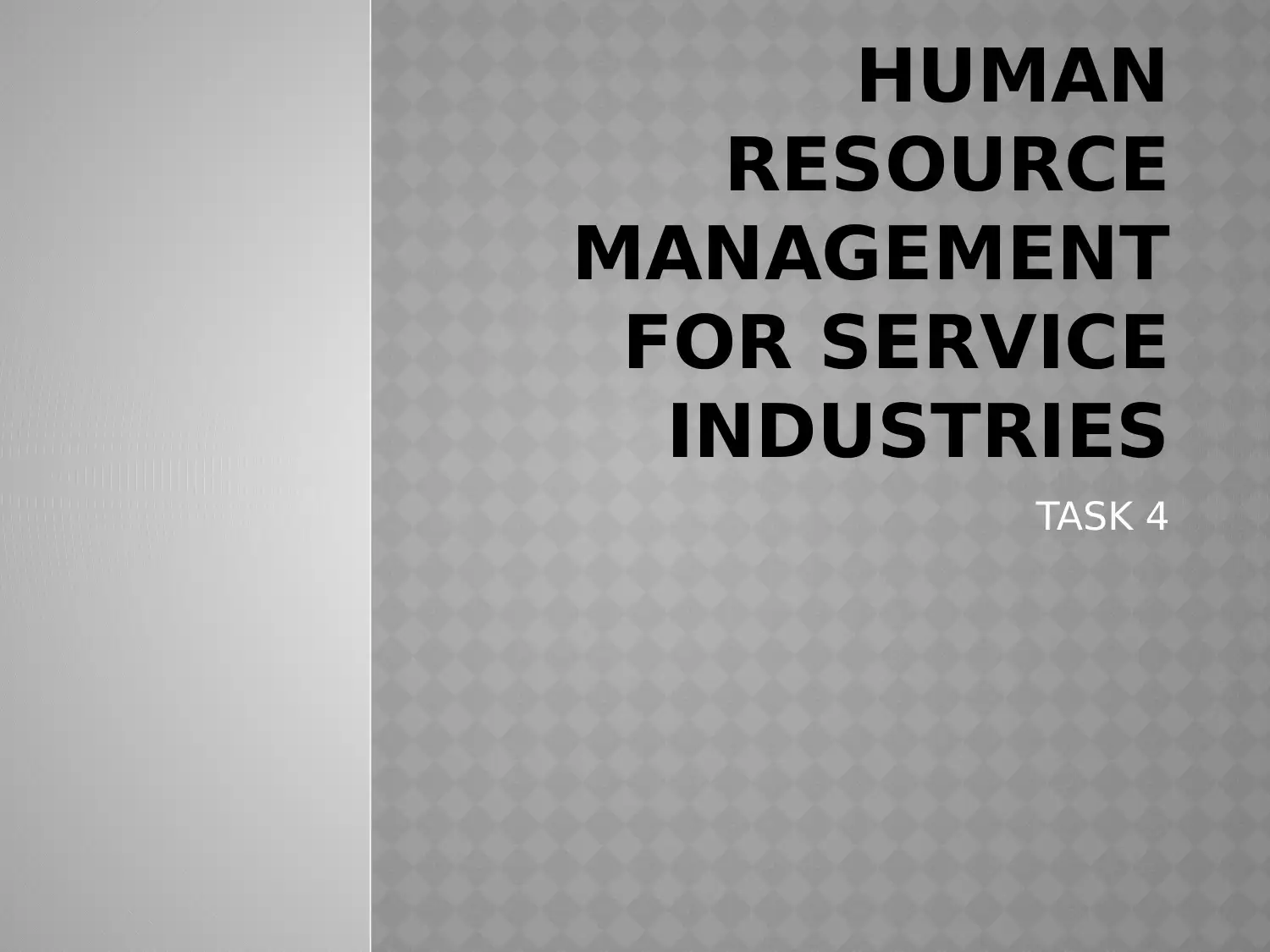
HUMAN
RESOURCE
MANAGEMENT
FOR SERVICE
INDUSTRIES
TASK 4
RESOURCE
MANAGEMENT
FOR SERVICE
INDUSTRIES
TASK 4
Paraphrase This Document
Need a fresh take? Get an instant paraphrase of this document with our AI Paraphraser

TASK 4
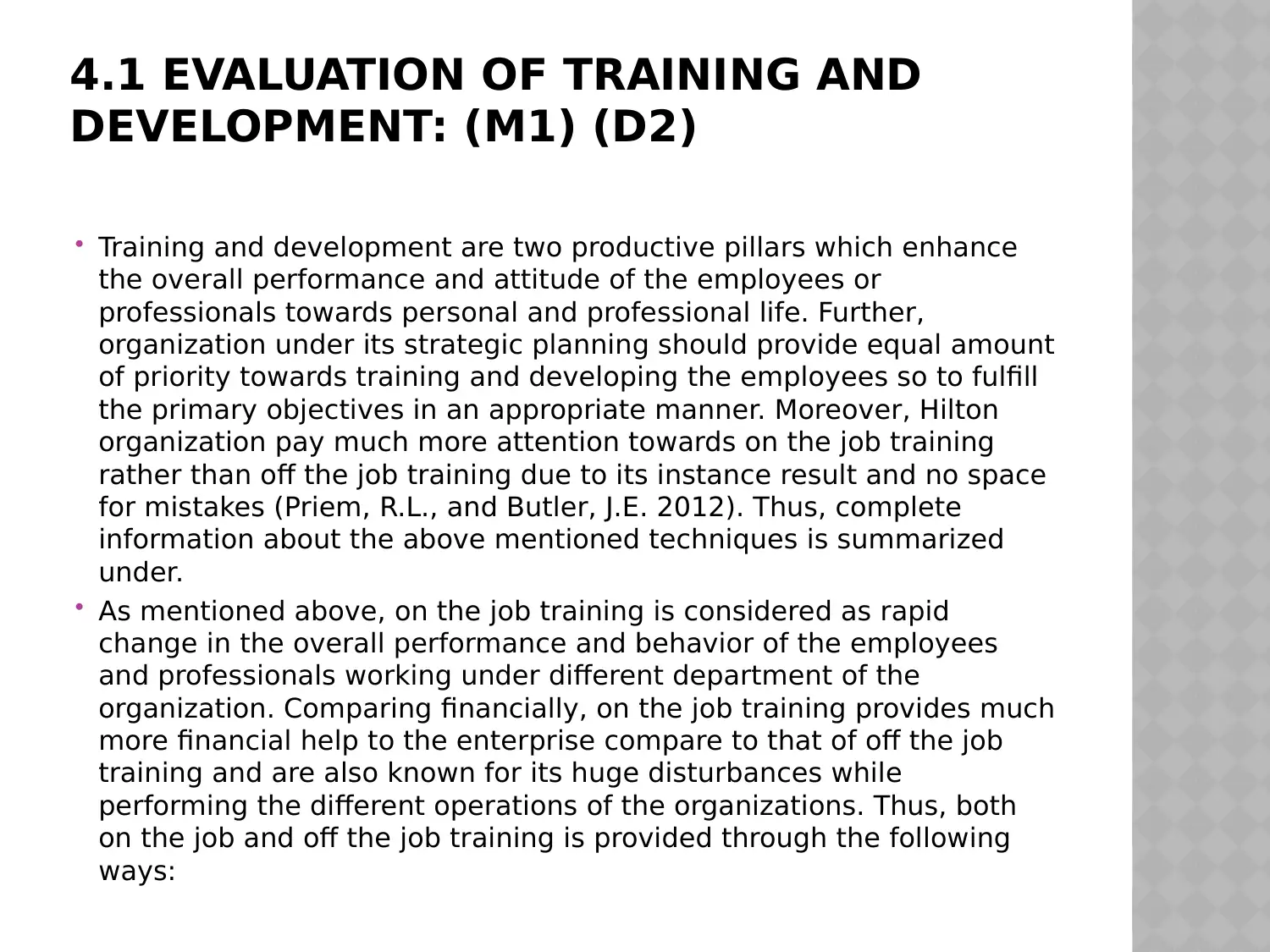
4.1 EVALUATION OF TRAINING AND
DEVELOPMENT: (M1) (D2)
Training and development are two productive pillars which enhance
the overall performance and attitude of the employees or
professionals towards personal and professional life. Further,
organization under its strategic planning should provide equal amount
of priority towards training and developing the employees so to fulfill
the primary objectives in an appropriate manner. Moreover, Hilton
organization pay much more attention towards on the job training
rather than off the job training due to its instance result and no space
for mistakes (Priem, R.L., and Butler, J.E. 2012). Thus, complete
information about the above mentioned techniques is summarized
under.
As mentioned above, on the job training is considered as rapid
change in the overall performance and behavior of the employees
and professionals working under different department of the
organization. Comparing financially, on the job training provides much
more financial help to the enterprise compare to that of off the job
training and are also known for its huge disturbances while
performing the different operations of the organizations. Thus, both
on the job and off the job training is provided through the following
ways:
DEVELOPMENT: (M1) (D2)
Training and development are two productive pillars which enhance
the overall performance and attitude of the employees or
professionals towards personal and professional life. Further,
organization under its strategic planning should provide equal amount
of priority towards training and developing the employees so to fulfill
the primary objectives in an appropriate manner. Moreover, Hilton
organization pay much more attention towards on the job training
rather than off the job training due to its instance result and no space
for mistakes (Priem, R.L., and Butler, J.E. 2012). Thus, complete
information about the above mentioned techniques is summarized
under.
As mentioned above, on the job training is considered as rapid
change in the overall performance and behavior of the employees
and professionals working under different department of the
organization. Comparing financially, on the job training provides much
more financial help to the enterprise compare to that of off the job
training and are also known for its huge disturbances while
performing the different operations of the organizations. Thus, both
on the job and off the job training is provided through the following
ways:
⊘ This is a preview!⊘
Do you want full access?
Subscribe today to unlock all pages.

Trusted by 1+ million students worldwide
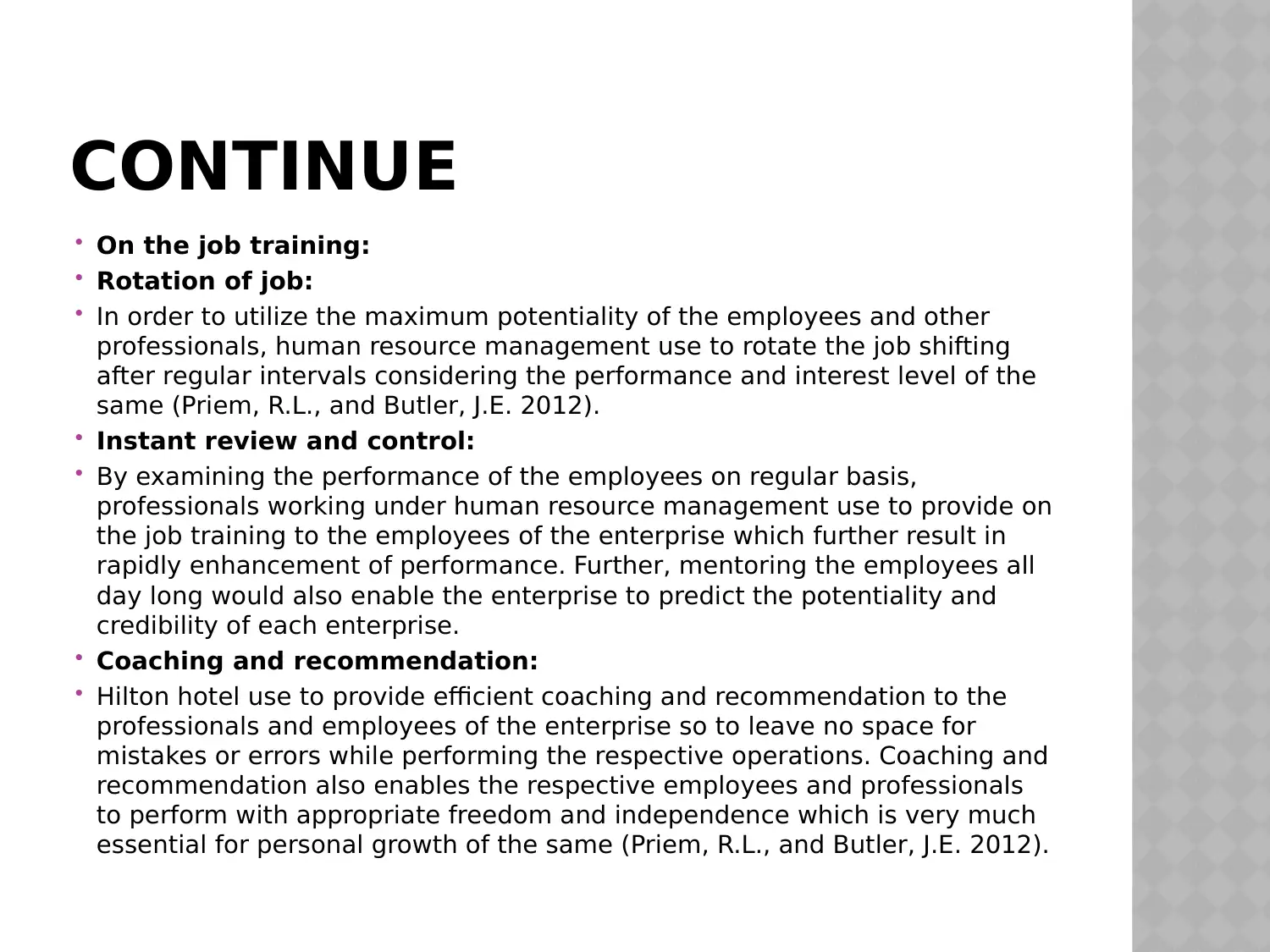
CONTINUE
On the job training:
Rotation of job:
In order to utilize the maximum potentiality of the employees and other
professionals, human resource management use to rotate the job shifting
after regular intervals considering the performance and interest level of the
same (Priem, R.L., and Butler, J.E. 2012).
Instant review and control:
By examining the performance of the employees on regular basis,
professionals working under human resource management use to provide on
the job training to the employees of the enterprise which further result in
rapidly enhancement of performance. Further, mentoring the employees all
day long would also enable the enterprise to predict the potentiality and
credibility of each enterprise.
Coaching and recommendation:
Hilton hotel use to provide efficient coaching and recommendation to the
professionals and employees of the enterprise so to leave no space for
mistakes or errors while performing the respective operations. Coaching and
recommendation also enables the respective employees and professionals
to perform with appropriate freedom and independence which is very much
essential for personal growth of the same (Priem, R.L., and Butler, J.E. 2012).
On the job training:
Rotation of job:
In order to utilize the maximum potentiality of the employees and other
professionals, human resource management use to rotate the job shifting
after regular intervals considering the performance and interest level of the
same (Priem, R.L., and Butler, J.E. 2012).
Instant review and control:
By examining the performance of the employees on regular basis,
professionals working under human resource management use to provide on
the job training to the employees of the enterprise which further result in
rapidly enhancement of performance. Further, mentoring the employees all
day long would also enable the enterprise to predict the potentiality and
credibility of each enterprise.
Coaching and recommendation:
Hilton hotel use to provide efficient coaching and recommendation to the
professionals and employees of the enterprise so to leave no space for
mistakes or errors while performing the respective operations. Coaching and
recommendation also enables the respective employees and professionals
to perform with appropriate freedom and independence which is very much
essential for personal growth of the same (Priem, R.L., and Butler, J.E. 2012).
Paraphrase This Document
Need a fresh take? Get an instant paraphrase of this document with our AI Paraphraser
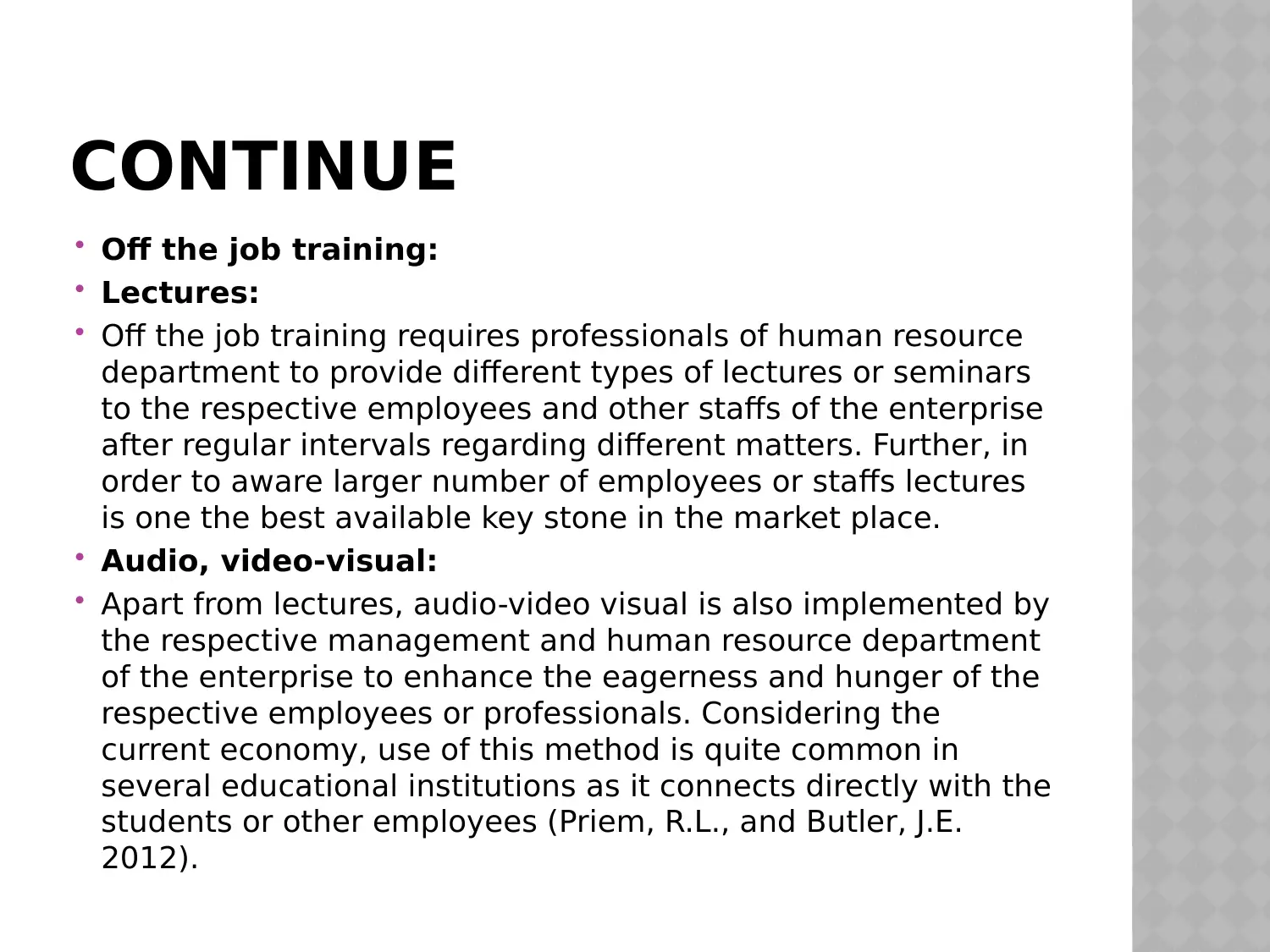
CONTINUE
Off the job training:
Lectures:
Off the job training requires professionals of human resource
department to provide different types of lectures or seminars
to the respective employees and other staffs of the enterprise
after regular intervals regarding different matters. Further, in
order to aware larger number of employees or staffs lectures
is one the best available key stone in the market place.
Audio, video-visual:
Apart from lectures, audio-video visual is also implemented by
the respective management and human resource department
of the enterprise to enhance the eagerness and hunger of the
respective employees or professionals. Considering the
current economy, use of this method is quite common in
several educational institutions as it connects directly with the
students or other employees (Priem, R.L., and Butler, J.E.
2012).
Off the job training:
Lectures:
Off the job training requires professionals of human resource
department to provide different types of lectures or seminars
to the respective employees and other staffs of the enterprise
after regular intervals regarding different matters. Further, in
order to aware larger number of employees or staffs lectures
is one the best available key stone in the market place.
Audio, video-visual:
Apart from lectures, audio-video visual is also implemented by
the respective management and human resource department
of the enterprise to enhance the eagerness and hunger of the
respective employees or professionals. Considering the
current economy, use of this method is quite common in
several educational institutions as it connects directly with the
students or other employees (Priem, R.L., and Butler, J.E.
2012).
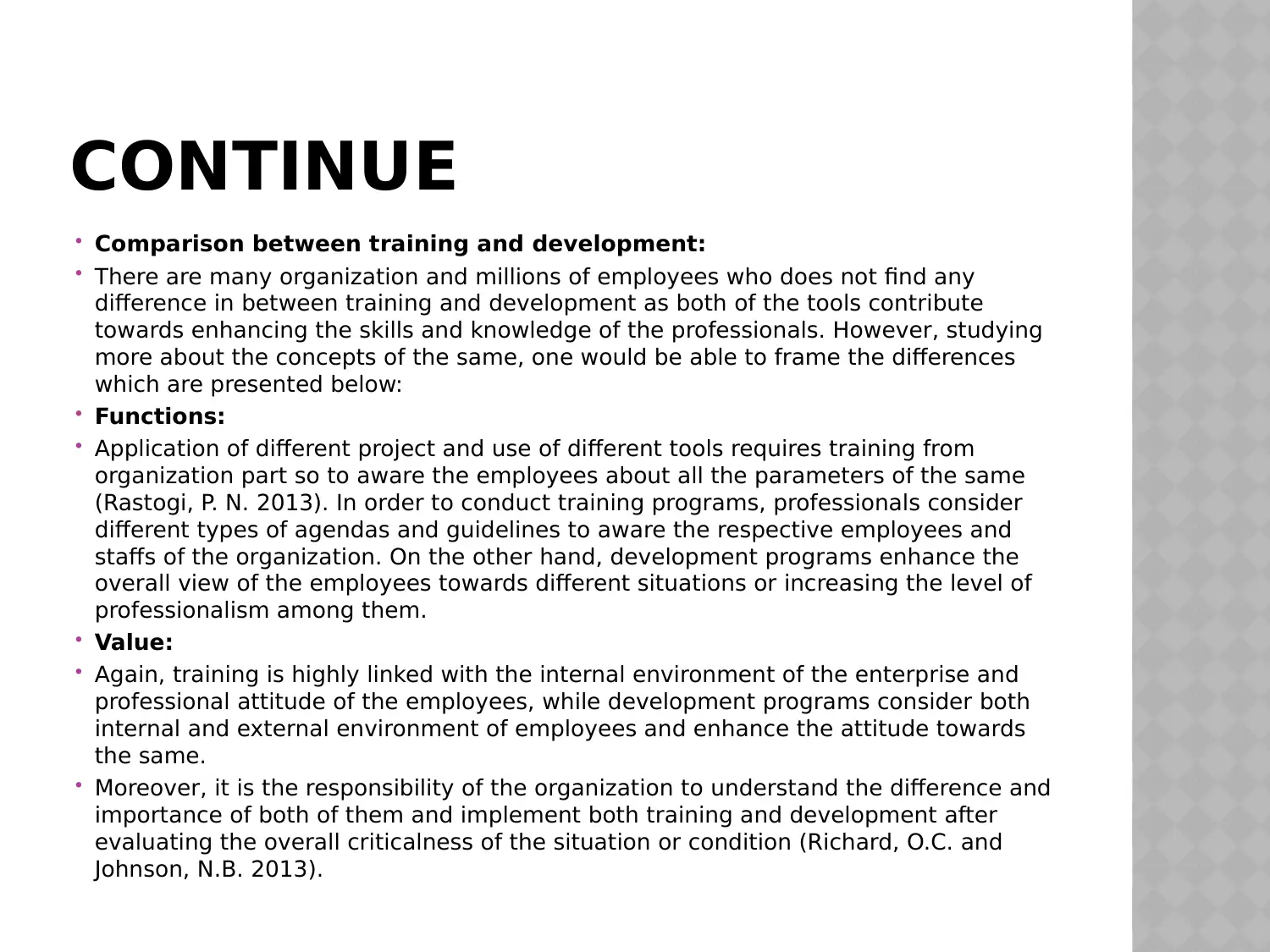
CONTINUE
Comparison between training and development:
There are many organization and millions of employees who does not find any
difference in between training and development as both of the tools contribute
towards enhancing the skills and knowledge of the professionals. However, studying
more about the concepts of the same, one would be able to frame the differences
which are presented below:
Functions:
Application of different project and use of different tools requires training from
organization part so to aware the employees about all the parameters of the same
(Rastogi, P. N. 2013). In order to conduct training programs, professionals consider
different types of agendas and guidelines to aware the respective employees and
staffs of the organization. On the other hand, development programs enhance the
overall view of the employees towards different situations or increasing the level of
professionalism among them.
Value:
Again, training is highly linked with the internal environment of the enterprise and
professional attitude of the employees, while development programs consider both
internal and external environment of employees and enhance the attitude towards
the same.
Moreover, it is the responsibility of the organization to understand the difference and
importance of both of them and implement both training and development after
evaluating the overall criticalness of the situation or condition (Richard, O.C. and
Johnson, N.B. 2013).
Comparison between training and development:
There are many organization and millions of employees who does not find any
difference in between training and development as both of the tools contribute
towards enhancing the skills and knowledge of the professionals. However, studying
more about the concepts of the same, one would be able to frame the differences
which are presented below:
Functions:
Application of different project and use of different tools requires training from
organization part so to aware the employees about all the parameters of the same
(Rastogi, P. N. 2013). In order to conduct training programs, professionals consider
different types of agendas and guidelines to aware the respective employees and
staffs of the organization. On the other hand, development programs enhance the
overall view of the employees towards different situations or increasing the level of
professionalism among them.
Value:
Again, training is highly linked with the internal environment of the enterprise and
professional attitude of the employees, while development programs consider both
internal and external environment of employees and enhance the attitude towards
the same.
Moreover, it is the responsibility of the organization to understand the difference and
importance of both of them and implement both training and development after
evaluating the overall criticalness of the situation or condition (Richard, O.C. and
Johnson, N.B. 2013).
⊘ This is a preview!⊘
Do you want full access?
Subscribe today to unlock all pages.

Trusted by 1+ million students worldwide
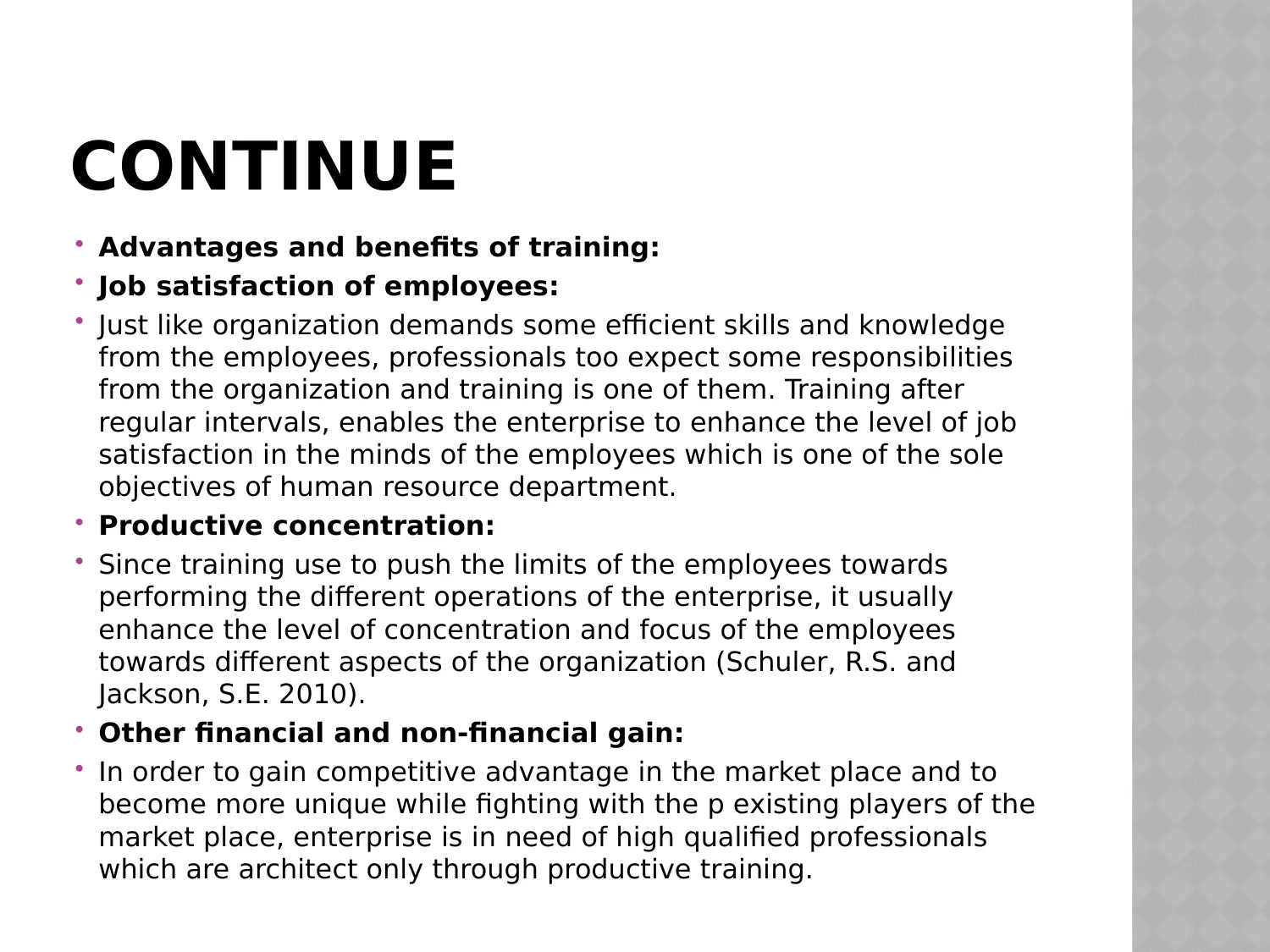
CONTINUE
Advantages and benefits of training:
Job satisfaction of employees:
Just like organization demands some efficient skills and knowledge
from the employees, professionals too expect some responsibilities
from the organization and training is one of them. Training after
regular intervals, enables the enterprise to enhance the level of job
satisfaction in the minds of the employees which is one of the sole
objectives of human resource department.
Productive concentration:
Since training use to push the limits of the employees towards
performing the different operations of the enterprise, it usually
enhance the level of concentration and focus of the employees
towards different aspects of the organization (Schuler, R.S. and
Jackson, S.E. 2010).
Other financial and non-financial gain:
In order to gain competitive advantage in the market place and to
become more unique while fighting with the p existing players of the
market place, enterprise is in need of high qualified professionals
which are architect only through productive training.
Advantages and benefits of training:
Job satisfaction of employees:
Just like organization demands some efficient skills and knowledge
from the employees, professionals too expect some responsibilities
from the organization and training is one of them. Training after
regular intervals, enables the enterprise to enhance the level of job
satisfaction in the minds of the employees which is one of the sole
objectives of human resource department.
Productive concentration:
Since training use to push the limits of the employees towards
performing the different operations of the enterprise, it usually
enhance the level of concentration and focus of the employees
towards different aspects of the organization (Schuler, R.S. and
Jackson, S.E. 2010).
Other financial and non-financial gain:
In order to gain competitive advantage in the market place and to
become more unique while fighting with the p existing players of the
market place, enterprise is in need of high qualified professionals
which are architect only through productive training.
Paraphrase This Document
Need a fresh take? Get an instant paraphrase of this document with our AI Paraphraser
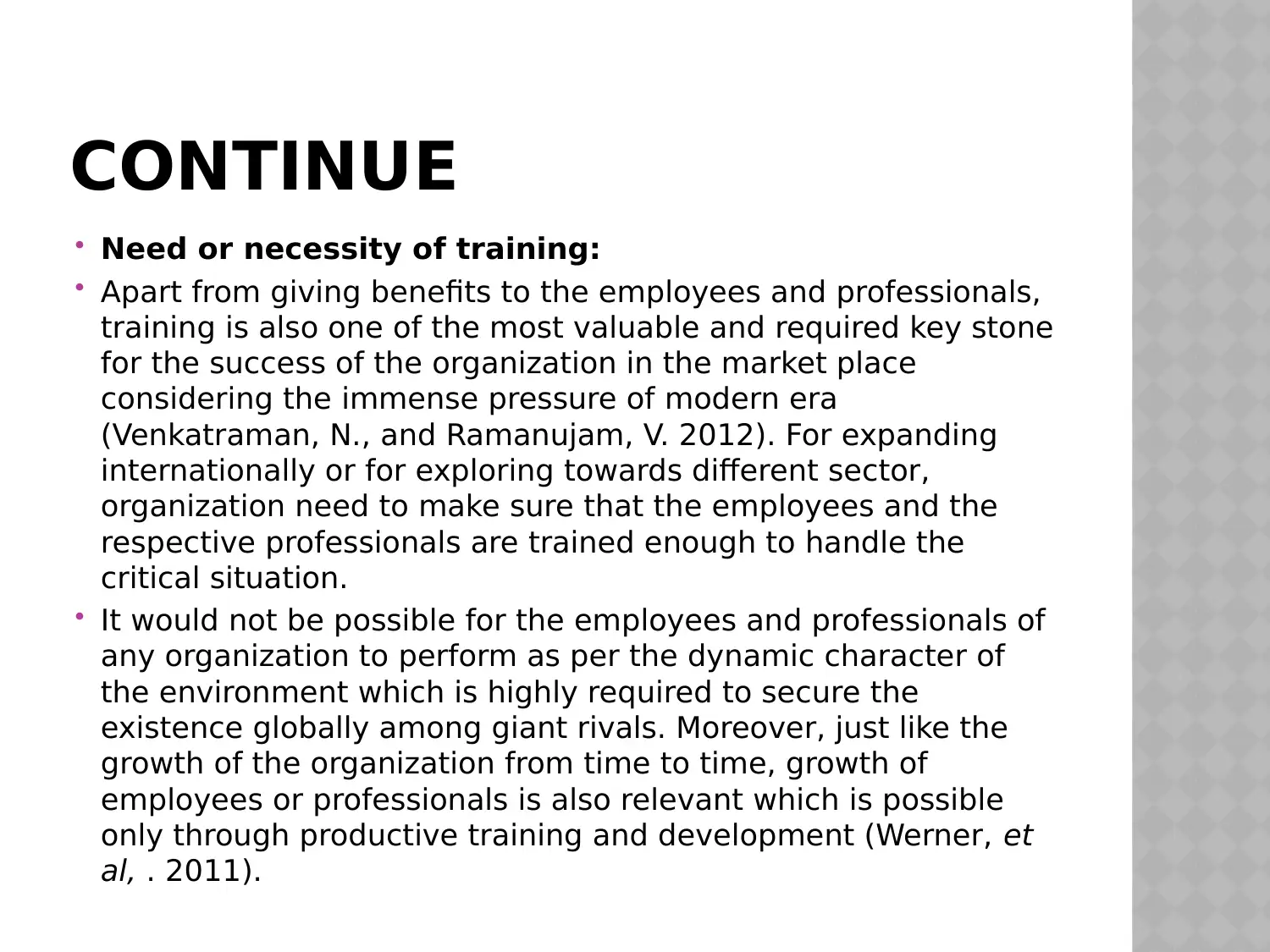
CONTINUE
Need or necessity of training:
Apart from giving benefits to the employees and professionals,
training is also one of the most valuable and required key stone
for the success of the organization in the market place
considering the immense pressure of modern era
(Venkatraman, N., and Ramanujam, V. 2012). For expanding
internationally or for exploring towards different sector,
organization need to make sure that the employees and the
respective professionals are trained enough to handle the
critical situation.
It would not be possible for the employees and professionals of
any organization to perform as per the dynamic character of
the environment which is highly required to secure the
existence globally among giant rivals. Moreover, just like the
growth of the organization from time to time, growth of
employees or professionals is also relevant which is possible
only through productive training and development (Werner, et
al, . 2011).
Need or necessity of training:
Apart from giving benefits to the employees and professionals,
training is also one of the most valuable and required key stone
for the success of the organization in the market place
considering the immense pressure of modern era
(Venkatraman, N., and Ramanujam, V. 2012). For expanding
internationally or for exploring towards different sector,
organization need to make sure that the employees and the
respective professionals are trained enough to handle the
critical situation.
It would not be possible for the employees and professionals of
any organization to perform as per the dynamic character of
the environment which is highly required to secure the
existence globally among giant rivals. Moreover, just like the
growth of the organization from time to time, growth of
employees or professionals is also relevant which is possible
only through productive training and development (Werner, et
al, . 2011).

⊘ This is a preview!⊘
Do you want full access?
Subscribe today to unlock all pages.

Trusted by 1+ million students worldwide
1 out of 9
Related Documents
Your All-in-One AI-Powered Toolkit for Academic Success.
+13062052269
info@desklib.com
Available 24*7 on WhatsApp / Email
![[object Object]](/_next/static/media/star-bottom.7253800d.svg)
Unlock your academic potential
Copyright © 2020–2025 A2Z Services. All Rights Reserved. Developed and managed by ZUCOL.





